FROSTBITE, AND THE TRIP HOME
 The 83rd division was taken out of the line on January 20th the 331st regiment was holed up near Aisne Belgium. This is where Uncle Rolland left the 331st never to return. On January 22nd 1945 two days after the division’s role in the Battle of the Bulge was over. Uncle Rolland checked into the 65th Evac hospital complaining that his feet hurt. He had fallen asleep in a ditch during the fighting around Bouviny when he awoke the next morning the temperatures had fallen significantly during the night and he was frozen from the waist down. From the 65th Evac he was moved to the 150th field hospital and then from there to the 67th General Hospital in England. Finally on May 13th five days after the war was officially over he was transported back to the U.S. to a convalescent Hospital at Fort Story in Virginia Beach Va.
The 83rd division was taken out of the line on January 20th the 331st regiment was holed up near Aisne Belgium. This is where Uncle Rolland left the 331st never to return. On January 22nd 1945 two days after the division’s role in the Battle of the Bulge was over. Uncle Rolland checked into the 65th Evac hospital complaining that his feet hurt. He had fallen asleep in a ditch during the fighting around Bouviny when he awoke the next morning the temperatures had fallen significantly during the night and he was frozen from the waist down. From the 65th Evac he was moved to the 150th field hospital and then from there to the 67th General Hospital in England. Finally on May 13th five days after the war was officially over he was transported back to the U.S. to a convalescent Hospital at Fort Story in Virginia Beach Va.
FORT STORY CONVALESCENT HOSPITAL
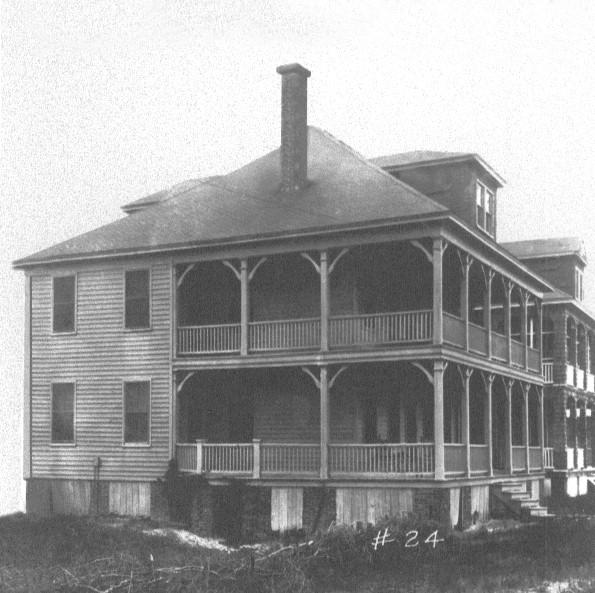 Fort Story dates back to 1914 when the Virginia General assembly ceded 343 acres to the Federal Government for military purposes. Construction of powder magazines and projectile rooms began in 1916, and in 1917 Fort Story was established as a coast artillery garrison.
Fort Story dates back to 1914 when the Virginia General assembly ceded 343 acres to the Federal Government for military purposes. Construction of powder magazines and projectile rooms began in 1916, and in 1917 Fort Story was established as a coast artillery garrison.
As World War II approached. Fort Story began an extensive development. Many of the facilities that exist today at Fort Story, were constructed during this period. The reservation increased in size to 1439.18 acres, an additional 11.82 acres were acquired in 1963 this increased the reservation to its present 1,451 acres. In 1940 temporary artillery batteries were added to battery Pennington until the permanent batteries could be constructed. These temporary batteries consisted of four 12 inch railway mortars, four 8-inch railway guns and four 155 MM guns. The two 16-inch howitzers making up battery Pennington ”B” were redesignated Battery Walke in 1940.
 While work was being done on the additional permanent batteries during 1940-41, other facilities were being constructed such as the theater, chapel, fire station, mess halls, barracks. Officer and NCO Clubs, shops, and other administrative type buildings. By 1942, the permanent batteries were beginning to be completed. Among those finished in 1942 were Battery No. 5 (mounting two 6-inch guns, M1903A2), and Battery No. 21 (mounting two 90-millimeter fixed guns, AAM1). The temporary railway batteries were removed by the end of 1942. During 1943, these batteries were accepted: Battery No. 1, Ketcham (mounting two 16-inch Navy rifles MK II, M1), Battery No. 4 (mounting two 16-inch Navy rifles MK II, M1), Battery No. 10 (mounting two 6-inch guns, M1), and Battery No. 19 (two 3-inch guns, 1902 M1).
The underground plotting room for Battery No. 1 was also completed in 1943. The year 1944 saw the completion of Battery No. 31 (mounting three 3-inch anti-aircraft guns, fixed, M1917), and the underground plotting room for Battery No 4. Additional powder magazines and projectile rooms were constructed for Walke Battery in 1944 as were six additional underground storage bunkers. By the end of 1944, Fort Story had, in addition to the mine Battery No. 7, a total of 35 guns ranging from 16-lnches to 90-millimeters. It also had 19 seacoast searchlights.
While work was being done on the additional permanent batteries during 1940-41, other facilities were being constructed such as the theater, chapel, fire station, mess halls, barracks. Officer and NCO Clubs, shops, and other administrative type buildings. By 1942, the permanent batteries were beginning to be completed. Among those finished in 1942 were Battery No. 5 (mounting two 6-inch guns, M1903A2), and Battery No. 21 (mounting two 90-millimeter fixed guns, AAM1). The temporary railway batteries were removed by the end of 1942. During 1943, these batteries were accepted: Battery No. 1, Ketcham (mounting two 16-inch Navy rifles MK II, M1), Battery No. 4 (mounting two 16-inch Navy rifles MK II, M1), Battery No. 10 (mounting two 6-inch guns, M1), and Battery No. 19 (two 3-inch guns, 1902 M1).
The underground plotting room for Battery No. 1 was also completed in 1943. The year 1944 saw the completion of Battery No. 31 (mounting three 3-inch anti-aircraft guns, fixed, M1917), and the underground plotting room for Battery No 4. Additional powder magazines and projectile rooms were constructed for Walke Battery in 1944 as were six additional underground storage bunkers. By the end of 1944, Fort Story had, in addition to the mine Battery No. 7, a total of 35 guns ranging from 16-lnches to 90-millimeters. It also had 19 seacoast searchlights.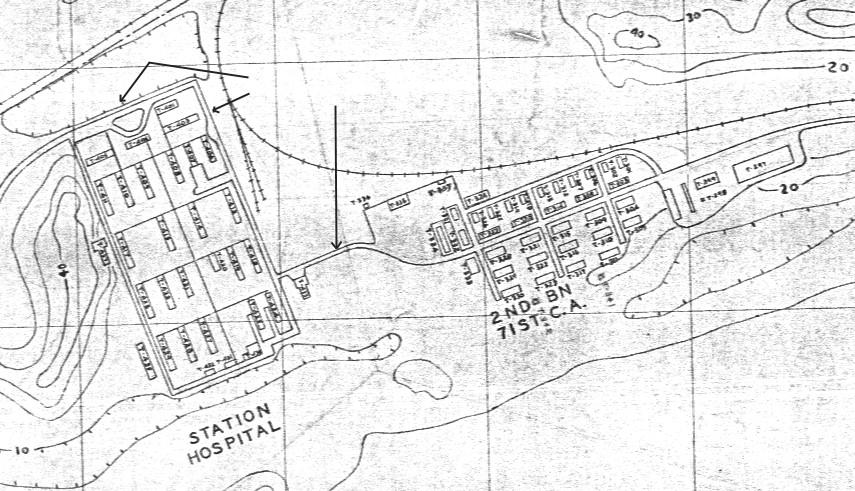 In December 1941, the Headquarters of the Harbor Defense Command was moved from Fort Monroe to Fort Story. Two additional harbor defense installations were added to the network in 1941. Fort John Curtis which was acquired in 1940 from the Wise estate, known as "Kiptopeke", was manned 19 December 1941 by Battery "D" 246th Coast Artillery. Also in December 1941, approximately 10,000 square feet were acquired from the Pennsylvania Railroad adjacent to the railroad ferry landing in Princess Anne County on Little Creek to be used as a mine base.
The little mine base accommodated the mine planters and minelaying batteries attached to the Harbor Defenses for mine field operations. With this expansion, the entrance to Chesapeake
Bay was well protected with Forts Story and John Curtis on opposite sides of the entrance. Fort Monroe and Fort Wool on the interior and a mine base of operations out of Little Creek.
On 1 March 1944,
In December 1941, the Headquarters of the Harbor Defense Command was moved from Fort Monroe to Fort Story. Two additional harbor defense installations were added to the network in 1941. Fort John Curtis which was acquired in 1940 from the Wise estate, known as "Kiptopeke", was manned 19 December 1941 by Battery "D" 246th Coast Artillery. Also in December 1941, approximately 10,000 square feet were acquired from the Pennsylvania Railroad adjacent to the railroad ferry landing in Princess Anne County on Little Creek to be used as a mine base.
The little mine base accommodated the mine planters and minelaying batteries attached to the Harbor Defenses for mine field operations. With this expansion, the entrance to Chesapeake
Bay was well protected with Forts Story and John Curtis on opposite sides of the entrance. Fort Monroe and Fort Wool on the interior and a mine base of operations out of Little Creek.
On 1 March 1944,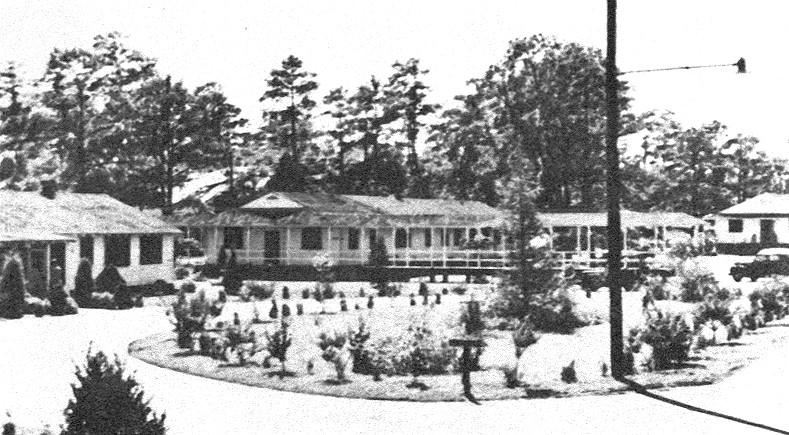 the Chesapeake Bay sector of the Harbor Defenses was inactivated, and control passed to Headquarters, Southeastern Sector, Eastern Defense Command, Raleigh, North Carolina.
By September 1944, Fort Story began a transition from a heavily fortified coast artillery garrison to a convalescent hospital.
The steady influx of wounded men coming in from the European Theatre of
Operations necessitated the expansion of hospital facilities. At the time of its closing on 15 March 1946, the hospital had accommodated over 13,472 patients. Though it was designed for a capacity of 1,800 beds there were at one time 2,700 patients on the rolls, with 900 on convalescent leave.
Rolland arrived at Fort Story in May 1945 he spent two months here until he was released.
the Chesapeake Bay sector of the Harbor Defenses was inactivated, and control passed to Headquarters, Southeastern Sector, Eastern Defense Command, Raleigh, North Carolina.
By September 1944, Fort Story began a transition from a heavily fortified coast artillery garrison to a convalescent hospital.
The steady influx of wounded men coming in from the European Theatre of
Operations necessitated the expansion of hospital facilities. At the time of its closing on 15 March 1946, the hospital had accommodated over 13,472 patients. Though it was designed for a capacity of 1,800 beds there were at one time 2,700 patients on the rolls, with 900 on convalescent leave.
Rolland arrived at Fort Story in May 1945 he spent two months here until he was released.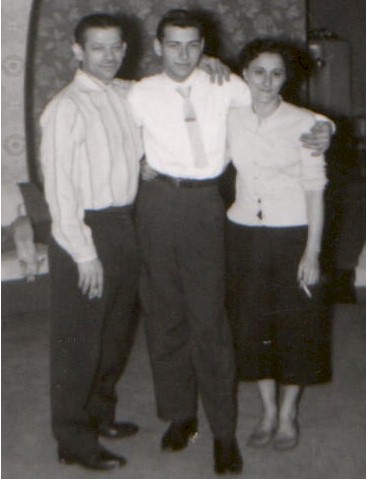 Rolland was finally released on 25 July 1945 and sent home to his wife Angie.
They remained in the Philadelphia area on York Street for many years. In the
late 1960s he moved from Philly to New Port Richey, near Pasco, Florida, where
he remained in peace until his death on August 31, 1992. Angie joined him two
months later. Rolland never spoke about the war to anyone. He had seen and done many things that he wanted to
forget, but couldn't. While researching for his story I came across his VA records. The records told of serious combat
neurosis that affected him up to the time he passed away. Only one time did he ever discuss the war with anyone, and that was to my father after viewing the movie
"The Longest Day"
in 1962. My father still vividly recalls his stories to this day. The stories that he passed on to me and I now pass onto all.
Rolland was finally released on 25 July 1945 and sent home to his wife Angie.
They remained in the Philadelphia area on York Street for many years. In the
late 1960s he moved from Philly to New Port Richey, near Pasco, Florida, where
he remained in peace until his death on August 31, 1992. Angie joined him two
months later. Rolland never spoke about the war to anyone. He had seen and done many things that he wanted to
forget, but couldn't. While researching for his story I came across his VA records. The records told of serious combat
neurosis that affected him up to the time he passed away. Only one time did he ever discuss the war with anyone, and that was to my father after viewing the movie
"The Longest Day"
in 1962. My father still vividly recalls his stories to this day. The stories that he passed on to me and I now pass onto all.
The story of the 83rd continues even though Uncle Rolland was evacuated on 22 January 1945. The 83rd went on to
fight in the Rhineland campaign and to great fame when they crossed the Elbe river and were within 65 miles of Berlin when they were ordered to stop.
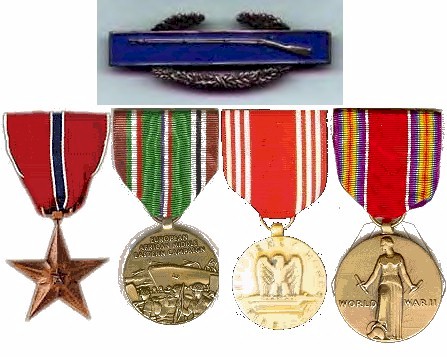
Uncle Rolland received the following decorations:
1. Combat Infantry Badge
2. Bronze Star
3. European African Middle eastern Campaign Medal with Three service stars
4. Army Good Conduct Medal
5. World War II Victory Medal

They
Served with Honor - Home
Page
 The 83rd division was taken out of the line on January 20th the 331st regiment was holed up near Aisne Belgium. This is where Uncle Rolland left the 331st never to return. On January 22nd 1945 two days after the division’s role in the Battle of the Bulge was over. Uncle Rolland checked into the 65th Evac hospital complaining that his feet hurt. He had fallen asleep in a ditch during the fighting around Bouviny when he awoke the next morning the temperatures had fallen significantly during the night and he was frozen from the waist down. From the 65th Evac he was moved to the 150th field hospital and then from there to the 67th General Hospital in England. Finally on May 13th five days after the war was officially over he was transported back to the U.S. to a convalescent Hospital at Fort Story in Virginia Beach Va.
The 83rd division was taken out of the line on January 20th the 331st regiment was holed up near Aisne Belgium. This is where Uncle Rolland left the 331st never to return. On January 22nd 1945 two days after the division’s role in the Battle of the Bulge was over. Uncle Rolland checked into the 65th Evac hospital complaining that his feet hurt. He had fallen asleep in a ditch during the fighting around Bouviny when he awoke the next morning the temperatures had fallen significantly during the night and he was frozen from the waist down. From the 65th Evac he was moved to the 150th field hospital and then from there to the 67th General Hospital in England. Finally on May 13th five days after the war was officially over he was transported back to the U.S. to a convalescent Hospital at Fort Story in Virginia Beach Va.





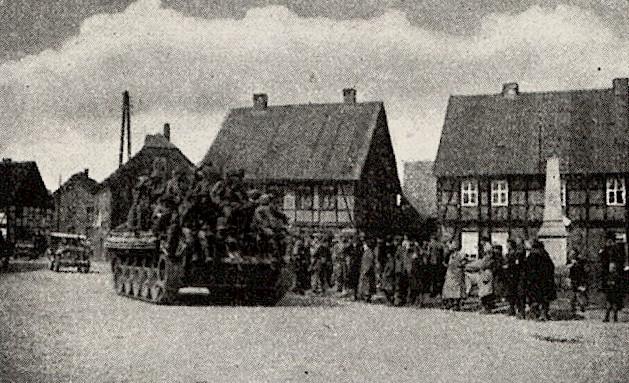 Germany:
The First to the Rhine and Crossing the Elbe
Germany:
The First to the Rhine and Crossing the Elbe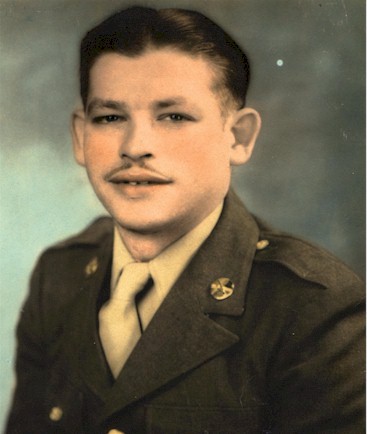 Rolland
Despres: Homepage
Rolland
Despres: Homepage